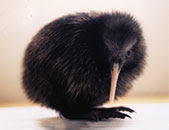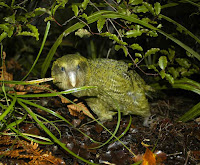Okay, for any of you evolutionary science geeks out there - this is amazing! This article was on the front page of the Dominion Post this morning, and it's pretty exciting stuff. (No, really, it is!).
They've discovered fossils of an ancient mouse (17 million years old) in a New Zealand lake bed, and it's an incredibly significant find for NZ and for evolutionary theory in this country.
Up until now, scientists were aware of only three native New Zealand land mammals, which all happen to be bats - the greater short-tailed bat Mystacina robusta and its close relative the lesser short-tailed bat Mystacina tuberculata, and the New Zealand long-tailed bat Chalinolobus tuberculatus. No other native land mammals were thought to exist at all. This meant that over a period of 80 million years, in the isolated islands of New Zealand, other native creatures, especially birds, were able to take over the niches normally reserved for mammals. This is why scientists believe that the kiwi, for example, lost its wings - and with it, the ability to fly - because it didn't need them any more. It had made its home on the forest floor, undisturbed by predators and without any competition from the mammals that would occupy that niche in most of the rest of the world.
This meant that over a period of 80 million years, in the isolated islands of New Zealand, other native creatures, especially birds, were able to take over the niches normally reserved for mammals. This is why scientists believe that the kiwi, for example, lost its wings - and with it, the ability to fly - because it didn't need them any more. It had made its home on the forest floor, undisturbed by predators and without any competition from the mammals that would occupy that niche in most of the rest of the world. New Zealand has a wonderful collection of flightless birds - some now sadly extinct like the moa and the Stephens Island wren, and others hanging on by a thread such as the kiwi, the kakapo (the world's only flightless parrot), the takahe and the Campbell Island teal.
New Zealand has a wonderful collection of flightless birds - some now sadly extinct like the moa and the Stephens Island wren, and others hanging on by a thread such as the kiwi, the kakapo (the world's only flightless parrot), the takahe and the Campbell Island teal.
Sadly, the characteristic which made them unique also made them terribly vulnerable to predators when man showed up, bringing with him introduced species such as rats, cats, dogs, mustelids (stoats, weasels and ferrets) and possums. Islands are amazing places for the development of unique species. Because they are isolated and separated from everywhere else by water, species can sometimes evolve down paths which wouldn't be followed on large continents. Many of the native species of New Zealand, Australia, and the Galapogos Islands, for example, are not found anywhere else in the world. Many are all also competely lacking in any sort of anti-predator characteristics, especially in New Zealand where there were no predators, and therefore no evolutionary need to develop ways of protecting oneself against them.
Islands are amazing places for the development of unique species. Because they are isolated and separated from everywhere else by water, species can sometimes evolve down paths which wouldn't be followed on large continents. Many of the native species of New Zealand, Australia, and the Galapogos Islands, for example, are not found anywhere else in the world. Many are all also competely lacking in any sort of anti-predator characteristics, especially in New Zealand where there were no predators, and therefore no evolutionary need to develop ways of protecting oneself against them.
The discovery of this little waddling Kiwi mouse is fascinating, because not only is it a mammal in the "land of birds", it's also unlike any mammal ever found anywhere else in the world. It fills a gap in New Zealand's fossil history, but at the same time it opens up a whole host of questions, like:
How long did it exist in New Zealand? Are there other native New Zealand mammals we don't know about? Are there any descended from, or ancestors to, the waddling Kiwi mouse? Did it compete for resources with the flightless birds of New Zealand? Why did it become extinct? Could this mouse have been an evolutionary ancestor of our native bats?
Wonderful stuff. Let's hope they are able to continue the research into this exotic (and unexpected) find.
Here's the full article:The discovery of fossils from a waddling, mouse-sized mammal in a New Zealand lake bed has stunned scientists, and could force a "rethink" on the evolution of this country's animals.
The bones from the primitive mammal, described as unlike any mammal alive today, were discovered in sediment at least 16 million years old. They suggest the mammal was mouse-sized and walked by waddling.
Kiwi palaeontologist Trevor Worthy, originally from Masterton and now based at Adelaide University in Australia, said the fossils were found in the bed of Central Otago's Lake Manuherikia.
The find in the lake, where crocodiles swam 17 million years ago, not only fills a gap in the nation's fossil record, but may also help scientists worldwide understand more about the origin of mammals.
Mr Worthy was a world expert on moa when he was effectively forced out of New Zealand last year when the Foundation for Research Science and Technology rejected his application for a $200,000 grant over four years. Largely self-taught after becoming interested in fossils as a caver, he helped unearth a treasure-trove of "mega-fauna" fossils in Otago in 2002, including ancient crocodiles.
His co-author, Alan Tennyson, a Te Papa palaeontologist, said the fossil discovery was incredible.
"This will cause a rethink on the whole evolution of animals in New Zealand, which has been regarded as the land of birds. There is no doubt these are among the most important fossils ever found in New Zealand. It ranks with finding dinosaurs."
The two jawbones and one thigh bone of the primitive "mouse" are the first hard evidence New Zealand once had indigenous land mammals. Their global significance is they are unlike any other fossil mammal found anywhere else.
Interesting links
Technorati tags: waddling kiwi mouse, kiwi mouse, evolution, evolutionary theory, fossils, New Zealand, New Zealand mammals, flightless birds, kiwi, kakapo, islands, ecological niche, endangered species, native species, endemic species, predators, ecology, biology, conservation, science.
You are here: Home > Kiwi mouse that waddled
Wednesday, December 13, 2006
Kiwi mouse that waddled
Posted by
webweaver
at
10:47 pm
![]()
Labels: environmentalism, nature, New Zealand
Subscribe to:
Post Comments (Atom)








0 comments:
Post a Comment